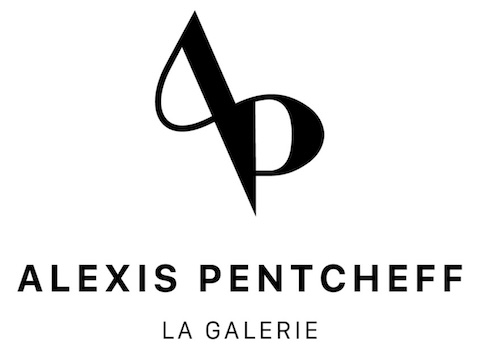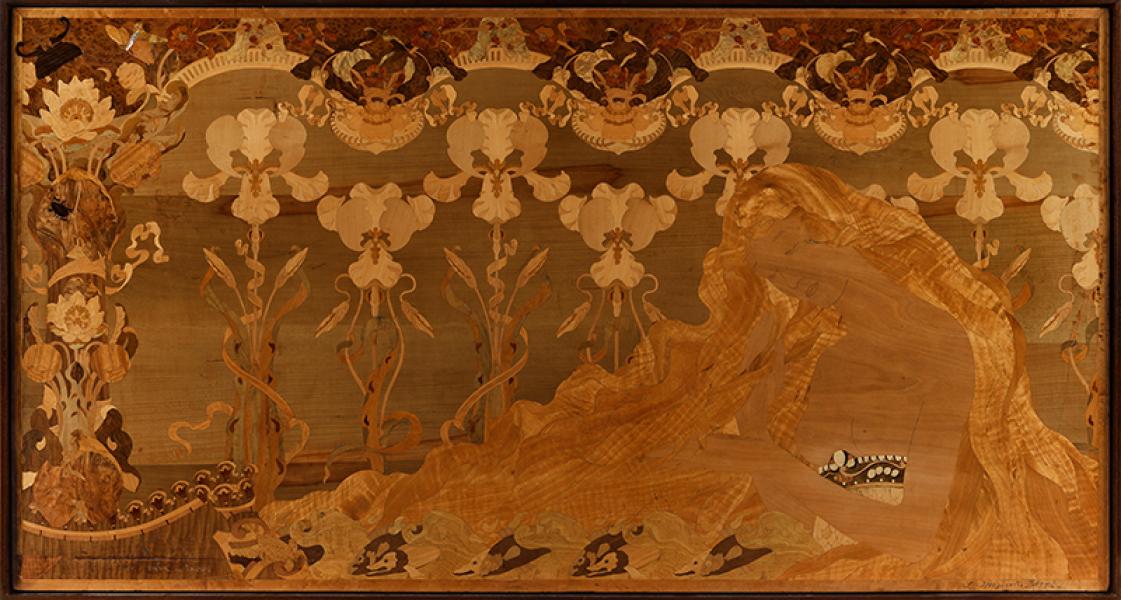La Source, 1894
Marquetry panel in veneered wood with mother-of-pearl inlays, signed and dated lower right, inscribed lower left with a quotation from Théophile Gautier’s poem La Source: “Peut-être deviendrai-je un fleuve / Baignant vallons, rochers et tours” (Émaux et Camées, 1852).
85 x 160 cm
Provenance:
Ateliers Majorelle, Nancy
Collection M.S. (collaborator of Louis Majorelle)
By descent within the family of M.S.
Galerie Alexis Pentcheff
Private collection, France
History:
This marquetry panel, executed after a composition by Jacques Gruber, was originally conceived as a tabletop. Its base, known only from a drawing published in Les arts décoratifs aux Salons de 1895 (Revue des arts décoratifs, p. 464), has not survived.
Presented in 1894 at the Exposition d’art décoratif et industriel lorrain and then in 1895 at the Salon des arts décoratifs—where it earned Majorelle a medal—the piece subsequently disappeared from public view. It resurfaced only in 2010, when the gallery acquired it from the descendants of one of Majorelle’s collaborators.
Exhibitions:
Exposition d’art décoratif et industriel lorrain, Salle Poirel, Nancy, 1894
Salon des arts décoratifs, Palais des Champs-Élysées, Paris, 1895
Literature:
Jules Rais, “L’art décoratif et industriel en Lorraine,” La Lorraine artiste, no. 32, 12th year, August 5, 1894 (described p. 271).
L. de Fourcaud, “Les arts décoratifs aux Salons de 1895,” Revue des arts décoratifs, vol. XV, 1894–1895, pp. 455–468 (panel described in the text, reproduced p. 465; table base illustrated p. 464).
La Lorraine artiste, June 2, 1895 (cited p. 220).
Exposition des ouvrages de peintures, sculpture, architecture, gravure et lithographie des artistes vivants exposés aux palais des Champs-Élysées le 1er mai 1895, 2nd ed., Paris, Imprimerie Paul Dupont, 1895, no. 3722.
Émile Nicolas, “Les meubles de Louis Majorelle,” La Lorraine, no. 4, 19th year, February 15, 1901.
Valérie Thomas (ed.), Jacques Gruber et l’Art Nouveau : un parcours décoratif, Paris, Gallimard, 2011.
La Source, 1894, Marquetry panel, collaboration between Louis Majorelle & Jacques Gruber
Gruber × Majorelle
At the end of the 19th century, Louis Majorelle (1859–1926), heir to a major furniture manufactory in Nancy, initiated a decisive turning point in the history of his house. Until then rooted in a tradition of bourgeois, historicist cabinetmaking, the Maison Majorelle moved closer to the modern movements heralding Art Nouveau.
It was in this context that Majorelle enlisted the talent of Jacques Gruber (1870–1936), a young artist trained at the École des Arts décoratifs in Paris, already recognized for his drawing skills and decorative sensibility. La Source is the only known surviving testimony of this occasional collaboration between the two artists: a marquetry panel produced by the Maison Majorelle after a design by Gruber. While period press and catalogues primarily credit Majorelle, Gruber’s contribution was essential. This shared authorship partly explains why the work long remained marginal in traditional historiography, until its rediscovery as a joint creation.
Gautier in filigree
The subject is an allegory of living water, rich in symbolism.
A monumental nymph embodies La Source, in a hieratic pose, her streaming hair surrounded by aquatic flora and fauna: irises and water lilies, stylized fish, and fluid motifs compose a true Symbolist scene.
Its literary character is underscored by a verse by Théophile Gautier, pyrographed into the wood:
“Peut-être deviendrai-je un fleuve,
Baignant vallon, rochers et tours.”
Such an inscription is rare in furniture of the period, and reflects the will to link the decorative arts with learned culture—a taste shared in Nancy’s artistic circles.
The execution is of remarkable virtuosity: more than fifteen precious woods (dyed sycamore for modeling, engraved pearwood for the nymph’s body, yellow peroba for the hair, Macassar ebony and amaranth for the fish, burl thuya, boxwood, elm, myrtle, amboyna…), enriched with mother-of-pearl inlays recalling Japanese burgauté techniques.
This freedom in combining materials and references situates the work at the crossroads of several currents—Pre-Raphaelitism, Symbolism, English Arts & Crafts, German Jugendstil—in an experimental approach foreshadowing future explorations.
A discreet chapter of Art Nouveau
Presented in Nancy in 1894 (Salle Poirel), then in Paris in 1895 (Salon des Arts décoratifs, Palais de l’Industrie) where it won a medal, La Source was conceived as the top of a table whose elaborately designed base, though illustrated, was never preserved.
Long known only through period literature (press and critical descriptions), the work’s rediscovery today makes it an exceptional document. It sheds new light on Majorelle’s pioneering role in Art Nouveau.
Indeed, La Source vividly illustrates Louis Majorelle’s early commitment to the movement, well before his affirmation at the turn of the century. It testifies to a pivotal moment: when the Maison Majorelle, still in rivalry with Émile Gallé, was already asserting its own language—naturalistic, poetic, and resolutely modern.
By its scale, technical richness, and symbolic depth, La Source must be considered a foundational milestone of Lorraine Art Nouveau, and a work of undeniable importance for the history of French furniture.

